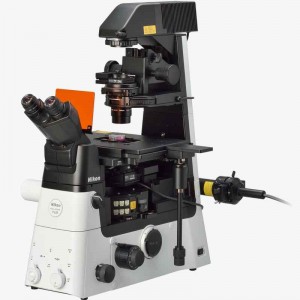Nikon Eclipse Ti2-A Inverted Research Microscope
Overview
Manual model with imaging capability for laser applications. Intelligent features provide interactive guidance through imaging workflows and automatic microscope status detection.
Key Features:
Groundbreaking FOV
As research trends evolve towards large-scale, systems-level approaches, there is an increasing demand for faster data acquisition and higher throughput capabilities. Development of large-format camera sensors and improvements in the data processing capabilities of PCs have facilitated such research trends. The Ti2, with its unprecedented 25mm field of view, provides the next level of scalability, enabling researchers to truly maximize the utility of large-format detectors and future-proof their core imaging platform as camera technologies continue to develop at a rapid pace.
Bright Illumination Over a Wide Area
High-power LEDs deliver bright illumination across the Ti2’s large field of view, ensuring clear, consistent results from demanding applications such as high-magnification DIC. Incorporation of a fly-eye lens design provides uniform illumination from edge to edge for quantitative high-speed imaging and seamless tiling of images in stitching applications.
Large Diameter Observation Optics
The diameter of the observation light path has been enlarged in order to achieve a field number of 25 at the imaging port. The resulting large FOV is capable of capturing approximately double the area of conventional optics, enabling users to gain maximum performance from large-format sensors such as CMOS detectors.
Objectives for Large FOV Imaging
Objectives with superior image flatness ensure high quality images from edge to edge. Utilizing the maximum potential of the OFN25 objective significantly accelerates data collection.
Cameras for large-volume data acquisition
The DS-Qi2 high-sensitivity monochrome camera and DS-Ri2 high-speed color camera are equipped with large 36.0 x 23.9 mm, 16.25 megapixel CMOS image sensors, enabling maximum performance with the Ti2’s large 25mm FOV.
Apodized phase contrast
Nikon’s unique apodized phase contrast objectives with selective amplitude filters dramatically increase contrast and reduce halo artifacts to provide detailed high-definition images.
DIC (Differential Interference Contrast)
Nikon’s highly-regarded DIC optics provide uniformly clear and detailed images with high resolution and contrast throughout the magnification range. DIC prisms are individually tailored for each objective lens to provide the highest-quality DIC images for every sample.
Epi-fluorescence
The Lambda series objectives, utilizing Nikon’s proprietary Nano Crystal Coat technology, are perfect for demanding, low-signal, multi-channel fluorescence imaging that requires high transmission and aberration correction over a wide wavelength range. Combined with new fluorescence filter cubes that offer improved fluorescence detection and stray light countermeasures such as the Noise Terminator, the Lambda series objectives demonstrate their power in weak signal observations such as single-molecule imaging and even luminescence-based applications.









